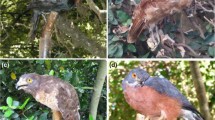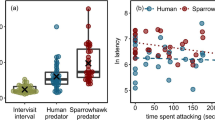Summary
Two semi-quantitative predictions about the intensity of defence against a predator based on the associated costs and benefits as a function of predator species, were examined in great tits (Parus major) feeding nestlings. One premise was that defence behaviour is adaptive. Defence comprised of vocalizing and homing in on a live raptor near the nest hole. The intensity of defence as judged by two measures of approaching (Minimum Distance, Average Distance) varies with the species of raptor, i.e. sparrowhawk ♀ (Accipiter nisus), pigmy owl (Glaucidium perlatum), and tawny owl (Strix aluco). With the exception of the response to the pigmy owl, defence intensities proved to conform to both predictions; the tits correctly assessed the relative overall risk from each predator (“predator pressure”) i.e. its degree of specialization on great tits, and the immediate risk of defence. The failure to verify the predictions regarding the pigmy owl is thought to derive from our incomplete assessment of the cost function and/or from the response being mal-adaptive.
The male takes a greater risk, exceeding the female's by an amount independent of the species of raptor. The sexual difference remains functionally unexplained.
Similar content being viewed by others
References
Ainley DG (1972) Flocking in Adélie Penguins. Ibis 114:188–390
Berndt R, Winkel W (1967) Die Gelegegröße des Trauerschnäppers (Ficedula hypoleuca) in Beziehung zu Ort, Zeit, Biotop und Alter. Vogelwelt 88:97–136
Bildstein KL (1982) Responses of northern harriers to mobbing passerines. J Field Ornithol 53:7–14
Corbet G, Ovenden D (1982) Pareys Buch der Säugetiere. Parey, Berlin Hamburg
Coss RG (1978) Development of face aversion by the jewel fish (Hemichromis bimaculatus, Gill 1862). Z Tierpsychol 48:28–46
Curio E (1969) Funktionsweise und Stammesgeschichte des Flugfeinderkennens einiger Darwinfinken (Geospizinae). Z Tierpsychol 26:394–487
Curio E (1975) The functional organization of anti-predator behavior in the pied flycatcher: A study of avian visual perception. Anim Behav 23:1–115
Curio E (1978) The adaptive significance of avian mobbing. I. Teleonomic hypotheses and predictions. Z Tierpsychol 48:175–183
Curio E (1980) An unknown determinant of a sex-specific atruism. Z Tierpsychol 53:139–152
Curio E (1983) Time-energy budgets and optimization. Experientia 39:25–34
Denson RD (1979) Owl predation on a mobbing crow. Wilson Bull 91:133
Ebersole JP (1977) The adaptive significance of interspecific territoriality in the reef fish Eupomacentrus leucostictus. Ecology 58:914–920
Endler JA (1978) A predator's view of animal color patterns. In: Hecht MK, Steere WC, Wallace B (eds) Evolutionary Biology, vol 11. Plenum Publ Corp, pp 319–364
Farr JA (1975) The role of predation in the evolution of social behaviour of natural populations of the guppy, Poecilia reticulata (Pisces: Poeciliidae). Evolution 29:151–159
Galloway DM (1970) The Oxford expedition to the Falkland Islands 1969. Predator recognition in two species of Falkland Islands passerines. Bull Oxf Univ Explor Club 18:27–54
Glutz v Blotzheim UN, Bauer KM, Bezzel E (1971) Handbuch der Vögel Mitteleuropas, Vol 4. Akad Verlagsgesellschaft, Frankfurt
Glutz v Blotzheim UN, Bauer KM (1980) Handbuch der Vögel Mitteleuropas, Vol 9. Akad Verlagsgesellschaft, Wicsbaden
Grubb TC Jr (1977) Discrimination of aerial predators by American coots in nature. Anim Behav 25:1065–1066
Hennessy DF, Owings DH (1978) Snake species discrimination and the role of olfactory cues in the snake-directed behaviour of the California ground squirrel. Behaviour 65:115–124
Hinde RA (1952) The behaviour of the great tit (Parus major) and some other related species. Behaviour Suppl 2:1–201
Hirsch SM, Bolles RC (1980) On the ability of prey to recognize predators. Z Tierpsychol 54:71–84
Huntingford FA (1982) Do inter- and intraspecific aggression vary in relation to predation pressure in sticklebacks? Anim Behav 30:909–916
Kruuk H (1964) Predators and anti-predator behaviour of the black-headed gull (Larus ridibundus (L.)). Behaviour 11:1–129
Losey GS (1981) Experience leads to attack of novel species by an interspecific territorial damselfish, Eupomacentrus fasciolatus. Anim Behav 29:1271–1272
Maynard Smith J (1974) Models in Ecology, Cambridge Univ Press, Cambridge
Moore FR (1978) Interspecific aggression: Toward whom should a mockingbird be aggressive? Behav Ecol Sociobiol 3:173–176
Niethammer G (1937–1942) Handbuch der deutschen Vogelkunde. Vol 1–3, Leipzig
Ortiz PR, Jenssen TA (1982) Interspecific aggression between lizard competitors, Anolis cooki and Anolis cristatellus. Z Tierpsychol 60:227–238
Owings DH, Coss RC (1977) Snake mobbing by California ground squirrels: Adaptive variation and ontogeny. Behaviour 62:50–69
Owings DH, Coss RC (1981) How ground squirrels deal with snakes. Anima 99:37–43
Phillips DW (1976) The effect of a species-specific avoidance response to predatory starfish in the intertidal distribution of two gastropods. Oecologia (Berlin) 23:83–94
Regelmann K, Curio E (in press) Determinants of brood defence in the great tit Parus major L. Behav Ecol Sociobiol
Regelmann K, Curio E, Völkel P, Zell RA (submitted) The benefits of avian mobbing: Dilution of risk or attack interference?
Ricklefs RE (1973) Fecundity, mortality, and avian demography. In: Farner DS (ed) Breeding biology of birds, Nat Acad Sciences, Washington, pp 366–435
Scherzinger W (1970) Zum Aktionssystem des Sperlingskauzes (Glaucidium passerinum (L)). Zoologica 118:1–120
Schönn S (1978) Der Sperlingskauz. Ziemsen Verlag, Wittenberg, Lutherstadt
Seghers BH (1973) An analysis of geographic variation in the antipredator adaptations of the guppy, Poecilia reticulata. Ph D thesis, Univ British Columbia
Seyfarth RM, Cheney DL, Marler P (1980) Vervet monkey alarm calls: semantic communication in a free-ranging primate. Anim Behav 28:1070–1094
Shalter MD (1979) Responses of nesting passerines to alarm calls. Ibis 121:362–368
Shedd DH (1982) Seasonal variation and function of mobbing and related antipredator behaviours of the American robin (Turdus migratorius). Auk 99:342–346
Smith S, Hosking E (1955) Birds fighting. Faber & Faber Ltd London
Snyder NFR, Snyder HA (1971) Defenses of the Florida apple snail Pomacea paludosa. Behaviour 40:175–215
Sokal RR, Rohlf FJ (1981) Biometry: The principles and practice of statistics in biological research, 2nd edn. Freeman, San Francisco
Thresher RE (1976) Field experiments on species recognition by the threespot damselfish Eupomacentrus planifrons (Pisces: Pomacentridae). Anim Behav 24:562–569
Thresher RE (1978) Territoriality and aggression in the threespot damselfish (Pisces: Pomacentridae): an experimental study of causation. Z Tierpsychol 46:401–434
Uttendörfer O (1952) Neue Ergebnisse über die Ernährung der Greifvögel und Eulen. Ulmer Stuttgart
Weldon PJ, Burghardt GM (1979) The ophiophage defensive response in crotaline snakes: extension to new taxa. J Chem Ecology 5:141–151
Author information
Authors and Affiliations
Rights and permissions
About this article
Cite this article
Curio, E., Klump, G. & Regelmann, K. An anti-predator response in the great tit (Parus major): Is it tuned to predator risk?. Oecologia 60, 83–88 (1983). https://doi.org/10.1007/BF00379324
Received:
Issue Date:
DOI: https://doi.org/10.1007/BF00379324




